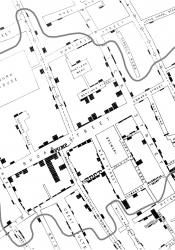John Snow's Cholera Map
In September 1854, England had to face its third cholera outbreak of the Nineteenth Century. The previous outbreak of 1848 had been absolutely devastating and reached epidemic status as it spread across England and Wales. People were wary of another outbreak, so when people started coming down with similar symptoms and dying in Soho, London, they feared the worst. John Snow was a doctor who lived relatively near Broad Street, the location of most of the new cases. Snow had been adamant in his belief that cholera was spread through water polluted with fecal matter after the 1848 epidemic, but he saw little support from his contemporaries, so he was determined to prove it once and for all.
Snow worked together with locals of Broad Street like the Reverend Henry Whitehead to gain information on who became sick and died. Many locals were worried about giving up this information because of how the government had treated those who were sick in 1848, but they trusted Whitehead. Snow marked each case of cholera on a map he created to visualize the patterns of infection. By the end of the outbreak, there had been over 600 deaths. He traced every case back to a single pump on Broad Street that was polluted from the leaking cesspools of nearby houses. In some cases, different pumps in the neighborhood were geographically closer to affected people, but the Broad Street pump was a shorter and straighter walk. The locals also claimed the water from the Broad Street pump tasted better than any other pump in the area.
Snow was not only looking for the people in the area who died from the polluted pump water. He was also looking for cases that did not fit the pattern. He found three such cases. First, the men who worked in the brewery on Broad Street did not get sick because they largely drank beer instead of water. Second, the workhouse that contained the poorest of the poor in Soho saw hardly any cases because they had their own water well to drink from. Third, an old woman who lived miles away in the neighborhood of Hampstead, London got sick along with her niece who lived with her. Snow discovered her family, who still lived on Broad Street, brought her water so she would not exhaust herself getting her own.
Snow now had irrefutable evidence that this Broad Street outbreak was caused by the polluted pump, and he convinced many of his peers in the medical profession as well as the local authorities. Unfortunately, the locals did not believe him for years afterwards, so he had to appeal to the authorities to have the pump handle completely removed.
John Snow is now considered a pioneer of epidemiology due to his data collecting and ability to visualize the patterns of infection on his famous map. His findings would also go on to support arguments for a better sewer system in London which greatly improved the health of the city and the people living in all of its neighborhoods.
Gilbert, Pamela K. “On Cholera in Nineteeth-Century England.” BRANCH: Britain, Representation and Nineteenth-Century History. Ed. Dino Franco Felluga. Extension of Romanticism and Victorianism on the Net. Web. Accessed 14 Oct. 2020.
John Snow, Cholera, the Broad Street Pump; Waterborne Diseases Then and Now. 2018. EBSCOhost, search.ebscohost.com/login.aspx?direct=true&AuthType=ip&db=edsgvr&AN=edsgcl.7433400015&site=eds-live&scope=site. Accessed 15 October 2020.
Video for more information:
Goodman, Alyssa. “John Snow and the 1854 Broad Street cholera outbreak.” Youtube, Uploaded by HarvardX, 19 April 2017, https://www.youtube.com/watch?v=lNjrAXGRda4. Accessed 14 October 2020.

